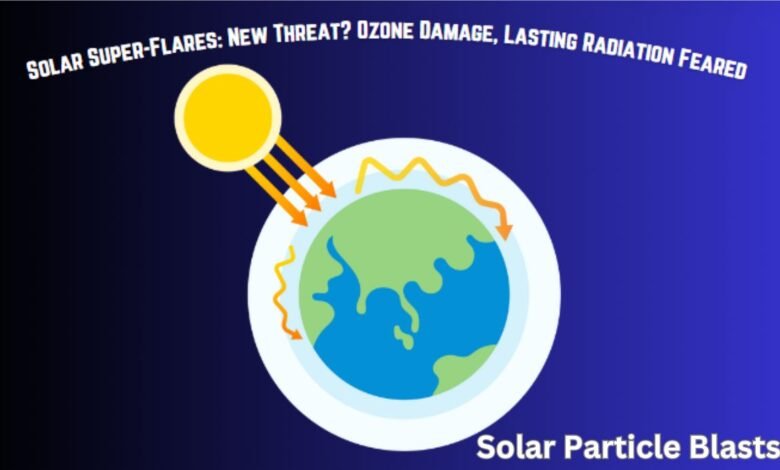Solar Particle Blasts: Ozone Damage Feared
Explore how solar particle blasts could damage Earth's ozone layer, raising concerns about environmental impacts and atmospheric health.

A recent study has illuminated the potentially severe impact of solar particle blasts on Earth’s ozone layer, revealing that these cosmic events can inflict damage lasting for years. Conducted by a consortium of leading scientific organizations, including NASA and the European Space Agency (ESA), this research marks a significant advancement in our understanding of space weather and its terrestrial consequences. The study is particularly noteworthy given the critical role the ozone layer plays in protecting living organisms from harmful ultraviolet (UV) radiation.
Solar particle blasts, also known as solar proton events (SPEs), occur when the sun emits high-energy particles during solar flares or coronal mass ejections. These particles travel at incredible speeds and can penetrate Earth’s magnetic field, reaching the stratosphere where the ozone layer resides. The study’s findings underscore the importance of monitoring solar activity and understanding its broader environmental impacts.
By analyzing data from multiple satellite missions and ground-based observations, the researchers were able to quantify the extent of ozone depletion caused by these solar particle blasts. Their results indicate that even a single powerful event can lead to significant ozone loss, which may persist for an extended period. This research is critical as it provides empirical evidence linking solar activity to long-term changes in atmospheric composition, challenging previous assumptions about the resilience of the ozone layer.
The implications of this study are manifold, affecting not just environmental policies but also our approach to space weather forecasting and satellite design. As solar activity is expected to increase with the approaching solar maximum, understanding the ramifications of solar particle blasts becomes increasingly urgent. This research paves the way for future studies aimed at mitigating the adverse effects of space weather on our planet.
What Are Solar Particle Blasts?
Solar particle blasts, also known as solar proton events (SPEs), are significant eruptions of energetic particles from the sun. These events are typically triggered by solar flares or coronal mass ejections (CMEs), which are massive bursts of solar wind and magnetic fields rising above the sun’s corona. When these particles, primarily protons, are accelerated to high energies, they can travel through space and impact Earth’s magnetosphere and atmosphere.
Here are some key characteristics of solar particle blasts:
- Origin: Solar particle blasts originate from the sun, specifically from solar flares and CMEs.
- Composition: They predominantly consist of protons, but also include electrons, alpha particles, and heavier ions.
- Energy Levels: The particles in an SPE can reach energies of tens of MeV (Mega-electron Volts) to several GeV (Giga-electron Volts).
- Speed: These energetic particles can travel at speeds close to the speed of light, reaching Earth within minutes to hours after their ejection from the sun.
- Impact: Upon reaching Earth, these particles can penetrate the magnetosphere and interact with the atmosphere, potentially affecting satellite operations, communication systems, and even the health of astronauts.
Solar particle blasts are a natural part of solar activity, which follows an approximately 11-year cycle known as the solar cycle. During periods of high solar activity, known as solar maximum, the frequency and intensity of SPEs increase. Monitoring and understanding solar particle blasts are crucial for space weather forecasting and mitigating their potential adverse effects on Earth’s technological infrastructure and atmospheric conditions.
Historical Perspective: Past Solar Events
The phenomenon of solar particle events (SPEs) impacting Earth is not new. Throughout history, significant solar activities have periodically influenced the planet’s atmospheric and radiation conditions. These events have been meticulously documented, providing a foundation for understanding the implications of solar activities. Below are some notable instances:
- Carrington Event (1859): This massive geomagnetic storm was caused by a coronal mass ejection (CME) that struck Earth’s magnetosphere. The event led to widespread telegraph system failures and produced spectacular auroras visible as far south as the Caribbean. While its direct impact on the ozone layer was not studied at the time, it remains a reference point for understanding solar storm intensity.
- August 1972 Solar Flare: This solar storm created significant disruptions in satellite communications and power grids. More critically, it was one of the first events to highlight the potential for solar particle events to influence Earth’s ozone layer, leading to increased interest and research in this area.
- Halloween Storms (2003): Occurring in late October, these solar storms resulted in extensive auroras and disrupted satellite systems. The storms were notable for their direct impact on the ozone layer, causing a measurable depletion that raised concerns about prolonged exposure to harmful ultraviolet radiation.
- September 2017 Solar Flares: These were the most powerful solar flares recorded in over a decade. They significantly affected high-frequency radio communications and led to temporary ozone layer damage, showcasing the ongoing relevance of studying solar particle events.
The new study builds on this historical knowledge by providing deeper insights into the mechanisms by which solar particle blasts can devastate the ozone layer. By examining past events in conjunction with contemporary data, researchers can better predict and mitigate the potential long-term effects of future solar activities. This historical context underscores the importance of continuous monitoring and research to safeguard Earth’s atmospheric integrity.
How Solar Particle Blasts Impact the Ozone Layer
Solar particle blasts, also known as solar proton events (SPEs), are high-energy particles emitted by the Sun, particularly during solar flares and coronal mass ejections. These energetic particles travel through space and can reach Earth’s atmosphere, where they interact with various atmospheric layers, including the ozone layer. Understanding how these interactions occur is crucial for comprehending their impact on Earth’s protective shield.
Here is a simplified explanation of how solar particle blasts affect the ozone layer:
- Penetration into Atmosphere: When solar particle blasts reach Earth, they penetrate the upper atmosphere and collide with molecules, primarily nitrogen and oxygen.
- Formation of Reactive Nitrogen and Hydrogen: These collisions produce reactive nitrogen (NOx) and hydrogen (HOx) species. These reactive species are highly efficient at catalyzing the destruction of ozone molecules.
- Ozone Depletion Cycle: The generated NOx and HOx species engage in chemical reactions that deplete ozone (O3). A single reactive nitrogen or hydrogen molecule can destroy thousands of ozone molecules before it is removed from the stratosphere.
- Reduction of Ozone Concentration: The depletion of ozone results in a reduction of the ozone concentration in the stratosphere. This thinning of the ozone layer diminishes its ability to absorb and filter out harmful ultraviolet (UV) radiation from the Sun.
- Increase in UV Radiation: With the ozone layer weakened, more UV radiation reaches Earth’s surface, posing significant health risks to living organisms, including increased rates of skin cancer and cataracts in humans, as well as adverse effects on ecosystems and wildlife.
The process by which solar particle blasts lead to ozone depletion is a complex interplay of high-energy physics and atmospheric chemistry. The increased UV radiation resulting from a depleted ozone layer underscores the importance of monitoring and understanding solar activity and its impacts on Earth’s atmosphere.
Consequences of Ozone Layer Depletion
The depletion of the ozone layer poses serious threats to human health, wildlife, and the environment. As the ozone layer weakens, it allows more harmful ultraviolet (UV) radiation to penetrate the Earth’s atmosphere. This increase in UV radiation can have a multitude of detrimental effects.
Human Health:
- Skin Cancer: Higher levels of UV radiation significantly increase the risk of skin cancer, including both melanoma and non-melanoma types.
- Eye Damage: Prolonged exposure to UV rays can lead to cataracts and other eye conditions, potentially resulting in vision impairment or blindness.
- Immune System Suppression: Increased UV exposure can weaken the human immune system, making individuals more susceptible to infections and diseases.
Wildlife:
- Terrestrial Animals: Many animals, particularly those with less fur or feathers, are at risk of skin damage and diseases due to heightened UV radiation.
- Marine Life: Phytoplankton, the foundation of the marine food web, are highly vulnerable to UV radiation. Their decline can disrupt the entire marine ecosystem, affecting fish and other sea creatures.
Environment:
- Crop Damage: Increased UV radiation can impair plant growth, reduce crop yields, and affect the nutritional quality of food crops. This can lead to food shortages and economic losses in agriculture.
- Forest Ecosystems: Forests play a crucial role in carbon sequestration and climate regulation. UV radiation can hinder the growth and health of trees, impacting these essential functions.
Given these significant risks, the preservation of the ozone layer is critical for safeguarding both human and environmental health. Efforts to mitigate ozone depletion must be prioritized to prevent these far-reaching consequences.
Duration and Extent of the Damage
The recent study has brought to light the prolonged impact a single solar particle blast can have on Earth’s ozone layer. According to the findings, the effects of such an event can persist for several years. Specifically, the study indicates that the ozone depletion caused by a single solar particle blast may last anywhere from two to five years, depending on the intensity and frequency of the solar activity. This long-term damage poses significant concerns for the sustainability of the ozone layer, which is crucial for protecting life on Earth from harmful ultraviolet radiation.
Moreover, the potential for cumulative damage becomes a critical issue when multiple solar particle blasts occur over a short period. The study highlights that successive blasts can compound the damage, leading to more severe and prolonged depletion of the ozone layer. This cumulative effect can result in an extended recovery period, further exacerbating the vulnerability of the ozone layer. The implications are particularly concerning for regions already experiencing ozone thinning, such as the polar areas, which are more susceptible to these atmospheric changes.
Geographically, certain areas are more vulnerable to the adverse effects of solar particle blasts. The study identifies the polar regions as particularly at risk due to the unique atmospheric conditions present there. The ozone layer over the Antarctic, for example, is already known to undergo significant seasonal depletion, commonly referred to as the ozone hole. The introduction of additional stress from solar particle blasts could hinder recovery efforts and prolong the period of reduced ozone concentration. Additionally, high-latitude regions in the Northern Hemisphere may also experience heightened vulnerability, potentially leading to increased levels of ultraviolet radiation reaching the surface and affecting ecosystems and human health.
Preventive Measures and Solutions
To mitigate the effects of solar particle blasts on the ozone layer and protect our planet from prolonged radiation exposure, a multifaceted approach is essential. This includes technological advancements, policy changes, and international cooperation. Here, we outline several potential measures and current initiatives aimed at addressing this critical issue.
Technological Advancements:
- Enhanced Satellite Monitoring: Developing more advanced satellite systems to monitor solar activity in real-time. These satellites can provide early warnings of solar particle blasts, allowing for timely implementation of protective measures.
- Ozone Layer Repair Technologies: Investing in research and development of technologies capable of repairing or replenishing the ozone layer. This includes exploring chemical treatments or atmospheric injections that could potentially restore ozone levels.
- Radiation Shielding: Innovating materials and techniques to shield critical infrastructure and communication systems from solar radiation. This can help minimize disruptions and maintain essential services during solar events.
Policy Changes:
- Stricter Emission Regulations: Implementing and enforcing stricter regulations on emissions of ozone-depleting substances. This can significantly reduce the overall burden on the ozone layer, making it more resilient to solar particle blasts.
- Global Environmental Policies: Promoting and supporting international agreements aimed at protecting the ozone layer. Policies such as the Montreal Protocol have already made significant strides, and similar efforts can further enhance global cooperation.
International Cooperation:
- Collaborative Research Initiatives: Encouraging countries to collaborate on research projects focused on understanding and mitigating the impacts of solar particle blasts. Sharing data and resources can accelerate the development of effective solutions.
- Global Early Warning Systems: Establishing a coordinated global network for early warning of solar particle events. This system can facilitate timely communication and response strategies across nations.
- Public Awareness Campaigns: Launching international campaigns to raise awareness about the importance of the ozone layer and the risks posed by solar particle blasts. Educating the public can foster a collective effort towards protective measures.
Current Projects and Initiatives:
Several initiatives are currently underway to address the challenges posed by solar particle blasts. For example, NASA’s Solar and Heliospheric Observatory (SOHO) and the European Space Agency’s Solar Orbiter are instrumental in monitoring solar activity. Additionally, the United Nations Environment Programme (UNEP) continues to play a key role in advocating for policies that protect the ozone layer.
By integrating advanced technologies, enacting stringent policies, and fostering international cooperation, we can effectively safeguard the ozone layer and mitigate the impact of solar particle blasts on Earth.
The Importance of Ongoing Research
The recent findings on the detrimental effects of solar particle blasts on Earth’s ozone layer underscore the critical need for ongoing research in this domain. Understanding and mitigating these impacts require a concerted and sustained effort from the scientific community. Continued research is essential not only to deepen our comprehension of the mechanisms through which solar particle events compromise the ozone layer but also to develop effective strategies to protect this vital component of our atmosphere.
International collaboration plays a pivotal role in advancing this research. Given the global nature of the ozone layer and the widespread implications of its depletion, it is imperative that nations work together, pooling resources and expertise. Collaborative efforts enable the sharing of data, the standardization of methodologies, and the acceleration of scientific breakthroughs. Funding from both governmental and private entities is crucial in supporting these initiatives, ensuring that researchers have the necessary tools and infrastructure to carry out their work effectively.
Several upcoming studies and initiatives are poised to make significant contributions to this field. For instance, the European Space Agency (ESA) is launching a series of missions aimed at monitoring solar activity and its effects on Earth’s atmosphere. Similarly, NASA’s upcoming missions will focus on gathering high-resolution data on solar particles and their interaction with the ozone layer. These initiatives, among others, represent a promising step forward in our quest to safeguard the ozone layer from the adverse effects of solar particle blasts.
Importance of ongoing research in understanding and mitigating the effects of solar particle blasts on the ozone layer cannot be overstated. Through international collaboration and adequate funding, we can make meaningful progress in protecting this essential component of our atmosphere, ensuring the well-being of our planet for future generations.
Conclusion: Staying Informed and Prepared
Understanding the impact of solar particle blasts on the ozone layer is vital for our future. By studying these events, scientists hope to develop strategies to mitigate their effects, protecting both our environment and our health. Stay informed and support research efforts to ensure a safer, healthier planet.
- Antikythera Mechanism (2024): New Insights from Gravitational Wave Research
- Big Pharma’s Bold Fight: 5 Bizarre Moves to Halt Price Reforms
- Space Intrigue: Unmasking the Mystery of Starliner’s Helium Leaks
FAQ: Solar Proton Events and the Ozone Layer
1. How does a solar proton event affect the stratospheric ozone?
Solar proton events unleash energetic particles, primarily protons, from the Sun. These particles interact with molecules in the Earth’s atmosphere, particularly at the poles during winter. This interaction creates nitrogen oxides and other compounds that can break down ozone molecules (O3) in the mesosphere and upper stratosphere.
However, the impact on lower stratospheric ozone, which shields Earth from harmful ultraviolet (UV) radiation, is debated. Some studies suggest a temporary decrease of up to 10% following strong SPEs, while others find little evidence of a direct effect.
2. Are solar wind energy particles a threat to life on Earth?
Solar wind itself consists of low-energy particles and doesn’t directly threaten life on Earth. However, during SPEs, the energetic protons can be harmful to astronauts and electronics in space.
The potential ozone depletion in the upper atmosphere due to SPEs might allow slightly more UV radiation to reach the lower atmosphere. However, the effect is usually small and temporary, and the existing ozone layer still provides significant protection.
3. Did a solar proton event cause a measurable change in Earth’s atmosphere?
Yes, large SPEs have been observed to cause measurable changes in the Earth’s atmosphere, particularly in the concentration of ozone in the upper and middle stratosphere. The January 2005 SPE is a well-documented example, leading to a noticeable decrease in ozone levels.
4. What causes solar proton events?
Solar proton events are triggered by powerful solar eruptions like solar flares or coronal mass ejections (CMEs). These events release enormous amounts of energy and charged particles, including protons, into space. The Earth’s magnetic field shields us from most of these particles, but strong SPEs can overwhelm the magnetosphere, allowing some protons to reach the atmosphere.



